 W
WDendropsophus is a genus of frogs in the family Hylidae. They are distributed in Central and South America, from southern Mexico to northern Argentina and Uruguay. They are sometimes known under the common name Fitzinger neotropical treefrogs or yellow treefrogs
 W
WDendropsophus acreanus is a species of frog in the family Hylidae. It is found in western Brazil, northeastern Bolivia, and southeastern Peru.
 W
WDendropsophus anceps is a species of frog in the family Hylidae. It is endemic to the lowlands of southeastern Brazil. Its natural habitats are open, stagnant water bodies (swamps), including man-made pools. There are no significant threats to this very common species.
 W
WDendropsophus arndti is a species of "clown tree frogs" described in 2017 that lives in the Amazon basin of Bolivia. The specific name arndti honors professor Rudolf G. Arndt, in recognition of his financial support for research and nature conservation.
 W
WDendropsophus bifurcus is a species of frog in the family Hylidae. It is found in the upper Amazon Basin of Bolivia, Brazil, Colombia, Ecuador, and Peru. Dendropsophus bifurcus is an abundant and widespread species that inhabits bushes in open forest and clearings. It breeds in permanent and temporary shallow ponds. Eggs are laid out of the water on leaves whereas the tadpoles develop in the water.
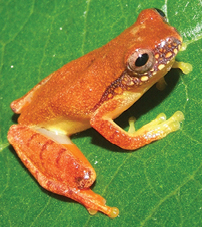 W
WDendropsophus bipunctatus is a species of frog in the family Hylidae. It is endemic to Brazil. Its natural habitats are subtropical or tropical moist lowland forests, subtropical or tropical moist montane forests, subtropical or tropical moist shrubland, subtropical or tropical seasonally wet or flooded lowland grassland, freshwater marshes, intermittent freshwater marshes, pastureland, and ponds.
 W
WDendropsophus bogerti is a species of frog in the family Hylidae. It is endemic to Colombia. Its natural habitats are subtropical or tropical moist montane forests, freshwater marshes, intermittent freshwater marshes, arable land, pastureland, plantations, rural gardens, urban areas, heavily degraded former forest, ponds, and irrigated land.
 W
WDendropsophus branneri is a species of frog in the family Hylidae. It is endemic to Brazil. Its natural habitats are dry savanna, moist savanna, subtropical or tropical dry shrubland, subtropical or tropical moist shrubland, subtropical or tropical dry lowland grassland, freshwater marshes, intermittent freshwater marshes, and pastureland.
 W
WDendropsophus brevifrons is a species of frog in the family Hylidae. It is found in Brazil, Colombia, Ecuador, French Guiana, Peru, and possibly Suriname. Its natural habitats are subtropical or tropical moist lowland forests, subtropical or tropical swamps, subtropical or tropical high-altitude grassland, intermittent freshwater marshes, pastureland, rural gardens, and urban areas. It is threatened by habitat loss.
 W
WDendropsophus columbianus is a species of frog in the family Hylidae. It is endemic to the Andes of Colombia. Dendropsophus columbianus is a common and adaptable species that lives in disturbed areas that formerly supported cloud forests; it has not been found in closed forests. It is typically associated with open habitats, especially those with some waterbodies.
 W
WDendropsophus cruzi is a species of frogs in the family Hylidae.
 W
WDendropsophus decipiens is a species of frog in the family Hylidae. It is endemic to eastern Brazil between the Pernambuco and Rio de Janeiro states, or following IUCN, between the Maranhão and São Paulo states. It is also known as Brazilian coastal treefrog.
 W
WDendropsophus bilobatus is a species of tree frog in the Hylidae family found on the east bank of the upper Madeira River, Brazil and possibly the surrounding Bolivian forests. This frog is differentiated from related species by its green bilobate vocal sac and call that consists of one to four monophasic notes at a dominant frequency of 8,979–9,606 Hz. It is a small frog, with males reaching only 18.8 to 20.8 mm SVL. They breed during the rainy season from November to March in flooded areas near rivers. The males start calling at twilight in branches around two meters above the ground or lower.
 W
WDendropsophus ebraccatus, also known as the hourglass treefrog or pantless treefrog, is a neotropical treefrog, found scattered throughout Central and South America from southern Mexico to northern Ecuador. The common names of D. ebraccatus come from the dark hourglass shaped pattern found in the centre of the back and the distinct smooth yellow thighs that contrast the rest of the brazenly patterned body. The contrasting of the smooth yellow thighs from the rest of the bodies pattern provide the illusion that D. ebraccatus is not wearing pants. The name ebraccata in Latin means "without trousers". D. ebraccatus has a number of unique reproductive features, such as the ability to alter rates of hatching shared in a number of Anura families. D. ebraccatus is also extremely unique in its ability to alter its mode of reproduction as it is the only known vertebrate to be able to do so.
 W
WDendropsophus elegans is a species of frog in the family Hylidae. It is endemic to Brazil. Its natural habitats are subtropical or tropical moist lowland forests, subtropical or tropical moist shrubland, subtropical or tropical seasonally wet or flooded lowland grassland, freshwater marshes, intermittent freshwater marshes, pastureland, plantations, heavily degraded former forest, and ponds.
 W
WDendropsophus elianeae is a species of frog in the family Hylidae. It is found in Brazil and possibly Paraguay. Its natural habitats are moist savanna, subtropical or tropical moist shrubland, freshwater marshes, and intermittent freshwater marshes. It is threatened by habitat loss.
 W
WDendropsophus giesleri is a species of frog in the family Hylidae. It is endemic to Brazil. Its natural habitats are subtropical or tropical moist lowland forests, subtropical or tropical moist montane forests, freshwater marshes, and intermittent freshwater marshes. It is threatened by habitat loss.
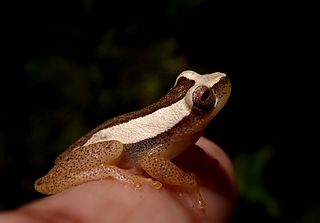 W
WDendropsophus haddadi is a species of frog in the family Hylidae. It is endemic to eastern Brazil, with its distribution ranging from northern Espírito Santo to Bahia, Sergipe, Alagoas, Pernambuco. The specific name haddadi honors Célio F. B. Haddad, a Brazilian ecologist and herpetologist.
 W
WDendropsophus jimi is a species of frog in the family Hylidae. It is endemic to Brazil. Its natural habitats are moist savanna, subtropical or tropical moist shrubland, subtropical or tropical high-altitude shrubland, rivers, swamps, freshwater springs, pastureland, rural gardens, ponds, and canals and ditches. It is threatened by habitat loss.
 W
WDendropsophus joannae is a species of frogs in the family Hylidae. It is known from the Pando Department, northern Bolivia, western Brazil, and Madre de Dios Region of southeastern Peru. It is similar to Dendropsophus leali but is smaller, has a shorter snout, more protuberant eyes, and more tuberculate dorsal skin. The specific name joannae honors Mrs. Jo Ann Oxley Foster, a BIOPAT patron supporting taxonomic research and nature conservation.
 W
WDendropsophus koechlini is a species of frog in the family Hylidae, known commonly as Koechlin's treefrog. It is found in Bolivia, Brazil, Peru, and possibly Colombia. Its natural habitats are subtropical or tropical moist lowland forests and intermittent freshwater marshes.
 W
WDendropsophus leucophyllatus is a species of frog in the family Hylidae. It is found in the Amazon Basin . This widespread and locally common species is found near water in a wide variety of tropical habitats. There are no known significant threats to this species.
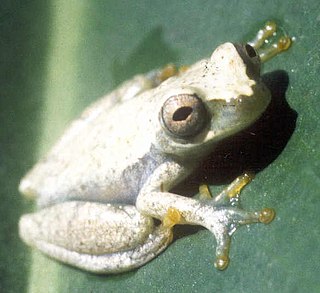 W
WDendropsophus luteoocellatus is a species of frog in the family Hylidae. It is endemic to Venezuela. Its natural habitats are subtropical or tropical moist lowland forests, subtropical or tropical moist montane forests, freshwater marshes, pastureland, rural gardens, heavily degraded former forest, urban sewer systems and ponds.
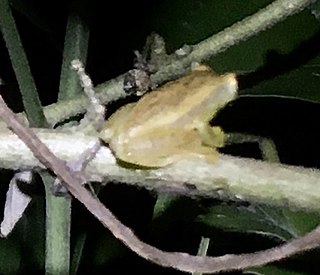 W
WDendropsophus mathiassoni, or Mathiasson's treefrog, is a species of frog in the family Hylidae that is endemic to Colombia. Its natural habitats are moist savanna, subtropical or tropical moist shrubland, freshwater marshes, intermittent freshwater marshes, pastureland, rural gardens, ponds, irrigated land, seasonally flooded agricultural land, and canals and ditches.
 W
WDendropsophus microcephalus is a species of frog in the family Hylidae. It is found in southeastern Mexico, Central America, and northern South America in Colombia, Venezuela, Trinidad and Tobago, the Guianas, and northern Brazil. This widespread species might actually be a species complex. Its common names include yellow treefrog, small-headed treefrog, and yellow cricket treefrog.
 W
WDendropsophus microps is a species of frog in the family Hylidae. It is found in Brazil and possibly Argentina. Its natural habitats are subtropical or tropical moist lowland forests, subtropical or tropical moist montane forests, subtropical or tropical moist shrubland, intermittent freshwater marshes, plantations, heavily degraded former forest, ponds, and canals and ditches. It is threatened by habitat loss.
 W
WDendropsophus minutus is a species of frog in the family Hylidae. It is found in Argentina, Bolivia, Brazil, Colombia, Ecuador, French Guiana, Guyana, Paraguay, Peru, Suriname, Trinidad and Tobago, Uruguay, and Venezuela. In Spanish it is known as ranita amarilla común.
 W
WDendropsophus molitor is a species of frog in the family Hylidae, known commonly as the green dotted treefrog. It is endemic to Colombia. Its natural habitats are subtropical or tropical high-altitude shrubland, subtropical or tropical high-altitude grassland, shrub-dominated wetlands, swamps, freshwater marshes, intermittent freshwater marshes, pastureland, plantations, rural gardens, urban areas, irrigated land, and seasonally flooded agricultural land.
 W
WDendropsophus nanus is a species of frog in the family Hylidae.
 W
WDendropsophus novaisi is a species of frog in the family Hylidae. It is endemic to Brazil. Its natural habitats are dry savanna, moist savanna, intermittent freshwater marshes, and rocky areas. It is threatened by habitat loss.
 W
WDendropsophus oliveirai is a species of frog in the family Hylidae. It is endemic to Brazil. Its natural habitats are subtropical or tropical dry forests, dry savanna, freshwater marshes, and intermittent freshwater marshes. It is threatened by habitat loss.
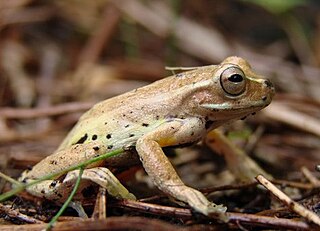 W
WDendropsophus padreluna is a species of frog in the family Hylidae. It is endemic to Colombia, being only known from its type locality in Albán, Cundinamarca Department.
 W
WDendropsophus parviceps is a species of frog in the family Hylidae. It is found in the Amazon Basin of Bolivia, Brazil, Colombia, Ecuador, Peru, and Venezuela. Dendropsophus parviceps is a locally common species with no known threats. These frogs are found on the leaves and branches in primary and secondary tropical rainforest, but also in open spaces close to forests. It is found in moist habitats. It breeds in temporary bodies of water. Eggs are laid in water where the tadpoles develop.
 W
WDendropsophus phlebodes, the San Carlos treefrog or San Carlos dwarf treefrog, is a species of frog in the family Hylidae. It is found in western Colombia, Costa Rica, Nicaragua and Panama. Its natural habitats are tropical moist lowland forests, but it may also occur in disturbed habitats. It is threatened by habitat loss.
 W
WDendropsophus rhodopeplus is a species of frog in the family Hylidae. It is found in the upper Amazon Basin in Bolivia, Brazil, Colombia, Ecuador, and Peru.
 W
WDendropsophus robertmertensi is a species of frog in the family Hylidae. It is found in the Pacific lowlands of El Salvador, Guatemala, and southeastern Mexico. A separate population exists in the Cintalapa Valley in Chiapas.
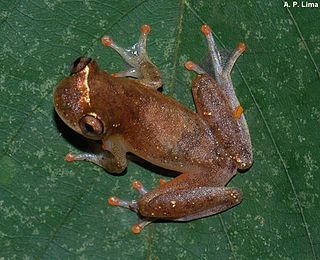 W
WDendropsophus rossalleni is a species of frog in the family Hylidae. It is found in Brazil, Colombia, Ecuador, Peru, and possibly Bolivia. Its natural habitats are subtropical or tropical moist lowland forests and intermittent freshwater marshes.
 W
WDendropsophus rubicundulus is a species of frog in the family Hylidae. It is found in Bolivia and Brazil. Earlier records from Paraguay are probably based on misidentified Dendropsophus jimi and Dendropsophus elianeae, but it is still likely to be also found in that country.
 W
WDendropsophus sanborni is a species of frog in the family Hylidae. It is found in Argentina, Brazil, Paraguay, and Uruguay. Its natural habitats are moist savanna, subtropical or tropical dry lowland grassland, subtropical or tropical seasonally wet or flooded lowland grassland, freshwater marshes, intermittent freshwater marshes, plantations, ponds, and canals and ditches.
 W
WDendropsophus sarayacuensis is a species of frog in the family Hylidae.
 W
WDendropsophus seniculus is a species of frog in the family Hylidae. It is endemic to Brazil. Its natural habitats are subtropical or tropical moist lowland forests, swamps, freshwater marshes, intermittent freshwater marshes, and rural gardens. It is threatened by habitat loss.
 W
WDendropsophus soaresi is a species of frog in the family Hylidae. It is endemic to Brazil. Its natural habitats are subtropical or tropical dry forests, dry savanna, moist savanna, subtropical or tropical dry shrubland, subtropical or tropical moist shrubland, freshwater marshes, and intermittent freshwater marshes. It is threatened by habitat loss.
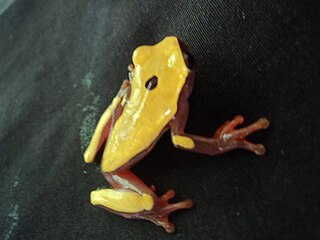 W
WDendropsophus triangulum is a species of frog in the family Hylidae. It is found in the upper Amazon Basin in Bolivia, western Brazil, Colombia, Ecuador, and Peru.